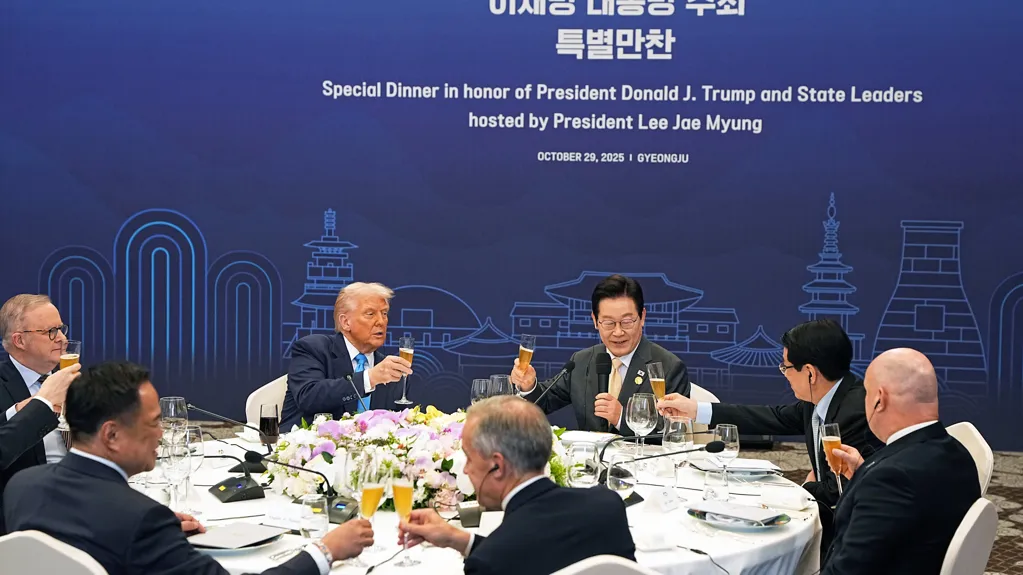South Korea said it had reached an agreement on the details of a long-awaited trade deal with the United States during President Trump's visit to the country, securing concessions on how much cash it would need to invest in the United States.
Kim Yong-beom, President Lee Jae Myung's chief of staff, announced the agreement on Wednesday after Mr. Trump and the South Korean leader met on the sidelines of the Asia-Pacific Economic Cooperation summit. It was the latest stop on a nearly weeklong trip to Asia by Mr. Trump that is expected to conclude on Thursday with a highly anticipated meeting with Xi Jinping, China's top leader.
The U.S. agreement with South Korea came after months of back-and-forth negotiations. Going into Mr. Trump's visit, expectations were low for a trade deal to be finalized. South Korea had agreed to a framework of a deal in July, but the two sides have struggled to find common ground on the details around Mr. Trump's demand that South Korea commit to investing $350 billion in the United States.
Initially, there was confusion on Wednesday evening over whether the sides had come to an agreement. Before a dinner with other leaders at the summit in Gyeongju, a historic city in South Korea's southeast, Mr. Trump said the United States had reached a deal. Then a little later, he seemed to walk back those comments, saying it had nearly finalized a deal.
Mr. Kim said that "the prospects for an agreement were not bright" but that the two sides had made "rapid progress today." He didn't elaborate.
A Trump administration official did not immediately respond to a request for comment.
Earlier in the day, officials flattered Mr. Trump during public events. Mr. Lee presented him with a medal symbolizing the nation's highest honor. Then came a replica of a golden crown that was excavated from one of the ancient royal tombs in Gyeongju, the seat of a long-gone kingdom. "I'd like to wear it right now," Mr. Trump said.
Until Wednesday, talks had been hung up in large part over the investment provision. The United States wanted a cash investment, but South Korea expressed concern that committing such a sizable sum of money could destabilize its currency.
According to Mr. Kim, the United States will now lower import tariffs on South Korean goods to 15 percent from the 25 percent rate that went into effect in August. In addition, he said the United States agreed to accept cash investments of up to $20 billion a year and set aside another $150 billion to invest in its American shipbuilding operations.
The two nations agreed that South Korea would invest in projects that were "commercially reasonable," Mr. Kim said. It would not invest as a lump sum up front but would spread out the money based on the progress made in those projects, he said.
That way, "we can minimize the impact on our foreign currency market," he said. South Korea's currency, the won, has lagged the dollar, eating into the country's buying power and causing alarm in a country where bitter memories of a financial crisis in the late 1990s still linger.
Mr. Kim said the two countries would appoint a South Korean manager to oversee the projects. The profits will be divided equally between South Korea and the United States until the principal and interest are repaid, he said.
South Korea added a provision to the agreement that would allow it to request adjustments to the timetable and the annual investment amount if the country faces financial instability, Mr.Kim said.
Andrew Yeo, a senior fellow and the Korea chair at the Brookings Institution's Center for East Asia Policy Studies, said the deal is a "huge relief" for the South Korean government and a major foreign policy win for the newly elected Mr. Lee.
South Korea scored more concessions and landed a generally less onerous deal than Japan, which has agreed to invest $550 billion in the United States under its trade deal. A memorandum of understanding between Washington and Tokyo stated that Mr. Trump will select how the money will be invested. If Japan goes against his wishes, he will have the right to impose higher tariffs.
Also, after Japan recoups its initial money on an investment, 90 percent of the profits would go to the United States.
South Korea must pass a bill through its National Assembly to implement the trade deal. The 15 percent tariff would take effect starting the first day of the month when such a bill is submitted for approval, Mr. Kim said, adding that the Lee administration would try to submit the bill next month. The governing party has majority control at the Assembly.
As one of the most advanced shipbuilding countries, South Korea is at the forefront of Mr. Trump's initiative to leverage foreign investment to turn around U.S. industry, which has fallen behind China's. South Korea has seemed to embrace its role, coining the slogan "MASGA," or Make American Shipbuilding Great Again.
South Korean companies will take the lead in deciding how to invest $150 billion in the American shipbuilding industry. The sum will include direct investments and loan guarantees, Mr. Kim said.
Hanwha, a South Korean conglomerate with shipbuilding operations in the United States, bought a shipyard in Philadelphia for $100 million last year. Hanwha, which also has a petrochemical business, announced that its ship-operating subsidiary had ordered 10 oil and chemical tankers from the Philadelphia plant—a significant order for an American yard.
But after the Trump administration started imposing fees this month on Chinese ships that dock at American ports, Hanwha became collateral damage in the trade war between Beijing and Washington. China announced that it would impose sanctions on five U.S. subsidiaries of Hanwha Ocean, the company's shipbuilding arm, accusing it of "supporting and assisting" the United States in its investigation into the trade practices of the Chinese shipbuilding industry.
